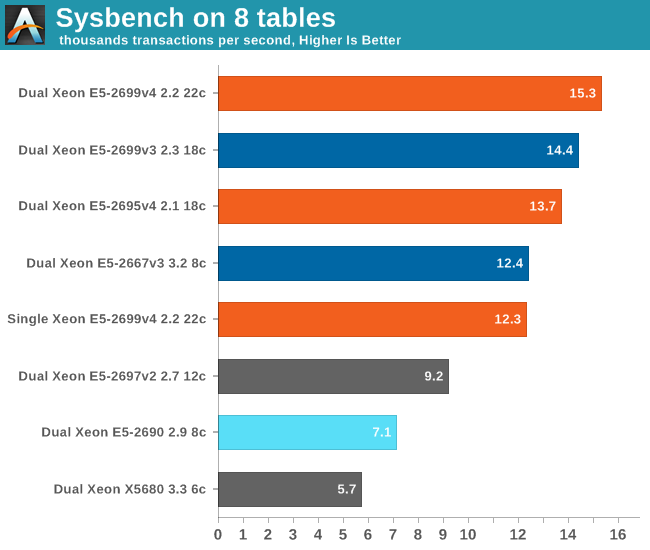The Intel Xeon E5 v4 Review: Testing Broadwell-EP With Demanding Server Workloads
by Johan De Gelas on March 31, 2016 12:30 PM EST- Posted in
- CPUs
- Intel
- Xeon
- Enterprise
- Enterprise CPUs
- Broadwell
MySQL 5.7.0
Thanks to the excellent repository of Percona, we were able to vastly improve our MySQL benchmark with Sysbench. However due to these changes, you cannot compare this with any similar Sysbench based benchmarking we have done before.
In updating our SQL benchmarking, we first upgraded the standard mysql installation to the better performing Percona Server 5.7. Secondly, we used sysbench 0.5 (instead of 0.4) and we implemented the (lua) scripts that allow us to use multiple tables (8 in our case) instead of the default one. This makes the Sysbench benchmark much more realistic as running with one table creates a very artificial bottleneck.
For our testing we used the read-only OLTP benchmark, which is slightly less realistic, but still much more interesting than most other Sysbench tests. This allows us to measure CPU performance without creating an I/O bottleneck. Our humble S3500 SSDs were fast enough in this scenario.

We used to apply all kinds of hacks to get around the limited scalability of both mysql and the way sysbench tested. Any version older than 5.5 could hardly scale beyond 8 cores. It is still not perfect, but MySQL uses the first 22 cores and 44 threads of the Xeon E5-2699 v4 amazingly well. We only get a 24% performance increase if we double the core count again with a second CPU, but we are honestly surprised that MySQL can now make good use of those 88 threads. Thanks to our better testing methods and a more scalable mysql, we can now report that the latest Xeon is capable of doubling the performance of the best Xeon that was launched 4 years ago. Well done Oracle, Percona, and Intel!










112 Comments
View All Comments
SkipPerk - Friday, April 8, 2016 - link
"Anyone putting Microsoft on bare hardware these days is nuts"This brother is speakin the truth!
warreo - Thursday, March 31, 2016 - link
Can someone clarify this line for me?"The average performance increase versus the Xeon E5-2690 is 3%, and the Broadwell cores get a boost of no less than 19%."
Does that mean IPC increase is 19% for Broadwell, offset by ~16% decline in clockspeed to get to 3% average performance increase? But that doesn't make sense to me as a 3.8ghz (E5-2690) to 3.6ghz (E5-2699 v4) is only 5% decline in max clockspeed?
ShieTar - Thursday, March 31, 2016 - link
I understood it as "the -Ofast setting boosts Broadwell by 19%", so with the -O2 setting it was actually 16% slower than the 2690.And I think the AT-Theory based on the original measurements is that the 3.6GHz boost are not even held for a significant amount of time, so that Broadwell in reality comes with an even worse decline in clock speed.
warreo - Thursday, March 31, 2016 - link
Your interpretation makes much more sense than mine, but still doesn't quite add up. The improvement from using -Ofast vs. -O2 is 13% on average, and the lowest improvement is 4% on the xalancbmk, well below the "no less than 19%" quoted by Johan.Perhaps the rest of the disparity is normalizing for sustained clock speeds as you suspect? Johan is that correct?
Ryan Smith - Thursday, March 31, 2016 - link
I've reworded that passage to make it clearer. But ShieTar's interpretation was basically correct."Switching from -O2 to -Ofast improves Broadwell-EP's absolute performance by over 19%. Meanwhile the relative performance advantage versus the Xeon E5-2690 averages 3%. "
JohanAnandtech - Thursday, March 31, 2016 - link
That means that the -ofast has much more effect on the Broadwell. I mean by that that -ofast is 19% faster than -o2 on Broadwell, while it is 3% faster on Sandy Bridge. I assume that the older the architecture, the better the compiler is able to optimize it without special tricks.warreo - Friday, April 1, 2016 - link
Thanks for the clarification. Loved the review, great work Johan!Pinn - Thursday, March 31, 2016 - link
I'm still happy I went with the 6 core x99 over the 8 core. Massive core count is nice to see available, but I don't see the true value. Looks like you have to do the same rough math to see if the clock speed reduction is worth the core count.Oxford Guy - Tuesday, April 5, 2016 - link
Why would there be "true value" for six and not for eight?Pinn - Wednesday, April 6, 2016 - link
Single threaded workloads.